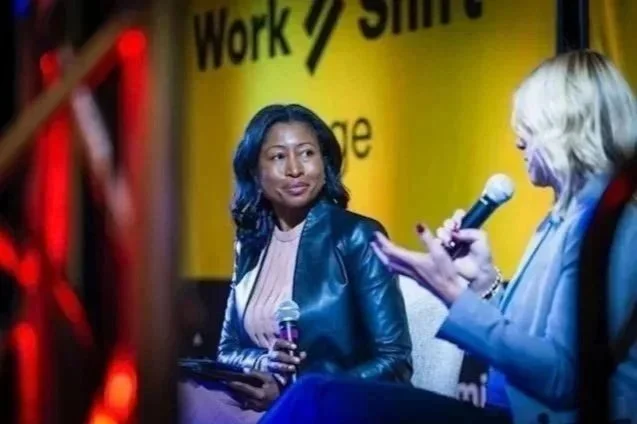A lesson from corporate America: Investing in teachers can transform education
By age 30, Angela Jackson—founder of the labor consultancy firm Future Forward Strategies and a lecturer at the Harvard Graduate School of Education—was the quintessential image of success: She had an MBA, earned a good salary as the Head of New Channels Marketing at Nokia, and had the path to climbing the corporate ladder plainly before her. She was also inches away from total burnout.
In need of major change, she decided to pursue a master’s in Education Leadership and focus her research on understanding the workplace conditions she found unsustainable. From her research, she soon understood that the best way for mutual success between employees and employers was in the proper investment in talent. She outlines her findings in her forthcoming book The Win-Win Workplace: How Thriving Employees Drive Bottom-Line Success. We spoke with Jackson about how this line of thinking can be applied to the major issues in education today.
How has your scholarship in Education Leadership informed your philosophy around transforming the workplace?
Education Leadership has taught me that effective transformation in any setting requires a commitment to continuous learning, inclusivity, and the fostering of environments where innovation and collaboration are encouraged. In education, we know that learners thrive when they feel seen, supported, and empowered. This same principle applies in the workplace. As I describe in The Win-Win Workplace, this holistic approach to valuing employees as whole individuals, rather than solely for their output, results in higher engagement, innovation, and productivity.
Leadership isn’t just about directing. It’s about empowering teams, creating opportunities for ownership, and ensuring that every voice is heard. When workplaces adopt these values, they foster a sense of belonging, which is essential for innovation and growth. Ultimately, this transformation leads to a win-win scenario, where both employees and organizations thrive.
Academia has been in crisis for some time. Tenure-track positions have been gutted while adjunct labor, which lacks benefits and adequate pay, has replaced these positions. K-12 is equally struggling with many teachers leaving the profession. How do you see the problems in the workplace that you articulate in your book at play in education? And how do you think this impacts students?
When educators are treated as disposable labor—lacking job security, fair compensation, and pathways for professional growth—their ability to contribute fully and effectively is compromised. To address these challenges, successful mentorship programs have emerged as effective solutions. For instance, partnerships between schools and local businesses allow teachers to engage in professional development while receiving guidance from industry leaders, fostering their growth and resilience in the profession.
In academia, the gutting of tenure-track positions and the over-reliance on adjunct labor creates a culture of precarity. Faculty without tenure are underpaid, and often excluded from the decision-making processes that shape their institutions. This has a profound effect on morale and limits the ability of educators to fully invest in their students and in the quality of education they provide. The K-12 sector is facing similar struggles, where the lack of support and overwhelming workloads are driving many teachers out of the profession altogether. In both cases, the failure to create sustainable, human-centered workplaces not only harms educators, but also undermines the quality of education that students receive. This directly impacts student engagement, learning outcomes, and overall well-being. These systemic issues underscore the need for transformative solutions, which can be found in workplace practices that prioritize employee well-being. Just as educational institutions must adapt to better support their educators, organizations in the corporate world can also implement strategies that foster an inclusive and thriving work environment.
How can higher education and K-12 apply the workplace solutions you describe in your book and what kind of transformative effect would that have on both students and schools as a whole?
As I share in The Win-Win Workplace, investing in people is essential for creating sustainable and successful environments. This includes rethinking labor models, ensuring job security, and fostering growth, not only in the corporate world but also in education. This can come in many forms like creating mentorship programs; addressing disparities in pay, workload, and access to resources; fostering collaboration between educators, administrators, and even students in decision-making processes; and offering sabbaticals to K-12 teachers. Ultimately, when we take care of our educators, we create a ripple effect that ultimately benefits students, schools, and society as a whole.
Your book takes aim at employers to prioritize employee well-being for mutual success. But what can college students do now to prepare themselves for both the current workforce and the transformed workplace you hope will come to fruition?
In a rapidly changing workforce, the ability to adapt and learn continuously is essential. College students should focus on building skills that can evolve as industries and roles change. This includes honing technical skills relevant to their fields while also strengthening soft skills like communication, problem-solving, and critical thinking, which are transferable across any profession. Being curious and open to learning—whether through internships, online courses, or new experiences—will ensure they stay ahead of trends and can thrive in an ever-evolving job market.
While skills are important, relationships matter just as much. Students should focus on building a diverse network and prioritizing emotional intelligence, which will make them better equipped to work in diverse teams and navigate complex interpersonal dynamics as well as allow them to develop the habits and boundaries necessary to maintain work-life balance as they enter the workforce.
Why is it important for employers to invest in educational opportunities for their employees?
With technology evolving constantly, the key to staying ahead is not just about adopting the latest tools, but also about how companies innovate with their human capital. Cross-training and providing opportunities for employees to gain a broader understanding of the business can make a huge difference. When people feel like they have a stake in the entire operation, it fosters a sense of ownership and engagement. This kind of culture isn’t just good for morale—it’s a strategic advantage. Employees who see the bigger picture are more invested and motivated, which translates to better outcomes for the company.




